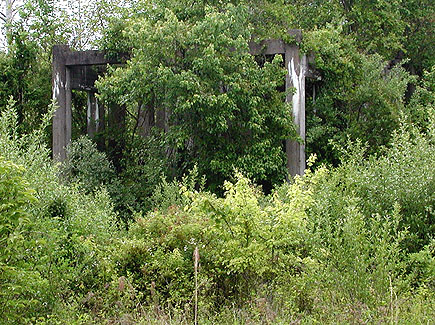This
is the home of the legendary Mothman
(if you believe in that sort of thing)

This trail accesses a parcel
of land which was a TNT plant during World War II.
Main Feature of the Trail: While most facilities used for manufacturing TNT at this site have been demolished, several interesting concrete structures remain. The structures are now partially obscured by vegetation and serve as a living example of how nature can reclaim itself in only a half-century.
Trail Condition:
Closed
Avenue of Trees:
About 25 half-century old native trees are identified along the
trail
What is TNT? 2,4,6-Trinitrotoluene is a yellow, odorless solid that does not occur naturally in the environment. It is commonly known as TNT and is an explosive used in military shells, bombs, and grenades, in industrial uses, and in underwater blasting. 2,4,6-Trinitrotoluene production in the United States occurs solely at military arsenals.
Impact on Point Pleasant: During the years of operation of WVOW, Point Pleasant
was a boom-town. Chemists, scientists, engineers, electricians,
plumbers, masons, heavy construction crews, and laborers representing
nearly every building trade were required for the rapid buildup.
Workers from all over the country converged on this area and
construction continued around the clock. Residents claim the
streets of downtown Point Pleasant were packed with people like
the streets of New York City. Ordinance School was hurriedly
constructed for the surge of children of construction workers
and staff personnel and was the first ever elementary school
built by the federal government. New housing additions were built
in Point Pleasant for plant workers. Housing was constructed
near the plant for military staff who oversaw and guarded the
facility. Local men working at the plant were exempted from military
service.
History of the WVOW: The official name of the site was
West Virginia Ordnance Works or WVOW. It was referred to by locals
as the TNT Plant because it produced explosives during World
War II. The facility was constructed on approximately 5,800 acres,
with more than 2,000 acres used as a safety zone. The site selected
for the plant had rail and water access via the nearby Ohio River.
The facility consisted of 10 TNT manufacturing lines, two acid
producing areas (North and South), acid loading areas on the
Ohio River, a sellite (sodium sulfite) plant, toluene storage,
two coal-fired power plants, pumping stations, 100 storage magazines,
wastewater holding ponds, burning grounds, an administrative
area, and employee housing.
Closing the TNT Plant: On August 6, 1945, the first atomic bomb was dropped on the city of Hiroshima, Japan. Less than a month later on September 2, 1945, Japan surrendered. As soon as workers learned the war was over, production of TNT ceased and plant shutdown was initiated. Local residents recall that TNT plant workers left the area in droves and the exodus of the Point Pleasant area occurred more rapidly than the buildup.
Due to changes to the landscape and deposits of harmful chemicals, the land was rendered unsuitable for farming. As a result of extensive cleanup and environmental testing efforts, selected parcels of the area have returned to private use, a game refuge and the Farm Museum.
Points of Interest:
South Acids Area: View interesting structures from the nature trail. These sturdy acid cradles were not demolished because of their sheer size and strength. Here you see evidence of how nature reclaims itself in our hot and humid climate in just a half century.
Sellite Manufacturing Area: (Inside fenced area) During WVOW operations, sellite (sodium sulfite) was manufactured through the combination of soda ash and sulfur. A box factory and storage building were also located on the site.
Following the suspension of the TNT manufacturing at WVOW, the site was used by the Mason Furniture Company for the manufacture of furniture from 1948 to the mid-1970s. The property was then leased by the West Virginia Mulch Company for the manufacture of mulch. Buildings now are used as museum storage and the land is used for demonstration farming
Geology:
The trail is on one of the main historic meanders of the Ohio
River The soil is a mixture of various layers of granularities
of sand and clay.
This is an historic educational exhibit
| The Museum | Animals
| Festivals | Plan a Visit | Map |
| What's
New | Staff | Volunteers | Make a Difference | Contact
Us | What's That? | Home
|